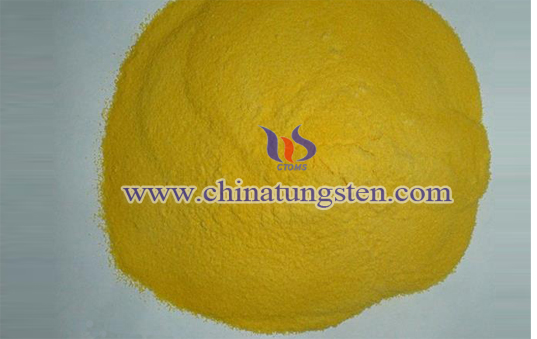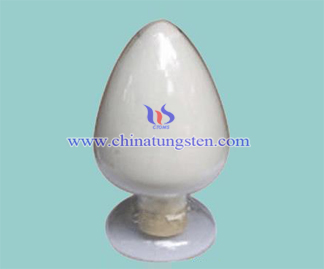Tungstic Acid

Introduction
Name: Tungstic Acid; Wolframic Acid
Formula: mWO3·nH2O
Relative Density: 5.5
CAS: 1314-35-8
Classification
Tungstic acid has a variety of forms, all of them are polymeric compounds which are combined with tungsten trioxide and water in different ratios, forms; among them yellow, white and partial tungstic acid are known.
Yellow Tungstic Acid
Yellow tungstic acid is a common acid, referred to as tungstic acid, a pale orange-yellow powder; the components slightly different with the different preparation conditions, when the composition is WO 3 • H 2 O, the relative density is 5.5g / cm 3 , 100℃ dehydration; it is insoluble in water, gradually gelled after dipping, dissolving in ammonia, alkaline solution and concentrated hydrochloric acid. It will generate WO 3 (the bright pale yellow crystals or powder) when burned, a density of 7.16g/cm 3 , a melting point of 1473 ℃. Yellow tungstic acid can be prepared by Sodium tungstate Na 2 WO 4 • 2H 2 O solution added hydrochloric acid to turned into poly sodium tungstate solution, and then the excess concentrated hydrochloric acid is added the hot solution. Yellow tungstic acid prepared in this way has impurity sodium, in recent years people have switched to ion exchange and solvent extraction.
White Tungstic Acid
The appearance of a microcrystalline white powder, n: m> 1.3 and differ with the different preparation and drying conditions. White tungstic acid has significant lively, slightly photosensitivity, and easily reducible; It can be prepared by adding dilute nitric acid into the sodium tungstate solution; or by nitric acid decomposition of peroxide tungstate solution to give white powdery tungstic acid, its lively is worse than the microcrystalline powdery white acid. It can be used for the preparation of a variety of tungsten containing acid and heteropoly acids, also tungsten carbide, and tungsten low valence metal cluster compounds.
Partial Tungstic Acid
Partial acid is a polylactic acid, the colorless crystal, the only one tungsten compound which has structure determined. It belongs to the same multiple of 12-tungstophosphoric acid, a simple formula of H 6 [H 2 (W 3 O 10 ) 4 ] • nH 2 O, n is 10 or 23; a density of 3.93g/cm 3 , decomposed when heated to 50 ℃ ; water solubility is very large, about 88.57g/cm 3 (25℃). It can be divided from the partial tungstic acid salt. Metatungstate is developed as the important industrial products in the late 1970s, mainly used as a catalyst. Ammonium metatungstate can get from the ammonium paratungstate, and the microcrystalline powdery white tungstic acid. Many other partial tungstic acids, including various metal salts and more bicarbonate salts, etc., can be obtained from microcrystalline powdery white tungstic acid made directly or indirectly. Ammonium paratungstate is another poly tungstate with the simple formula of (NH 4 ) 10 [H 2 W 12 O 42 ] • nH 2 O, prepared from sodium tungstate solution by ion exchange method, we can get the tungsten trioxide containing without sodium by burning ammonium paratungstate.
Application
1. For the mordant, analytical reagents, catalysts, water treatment chemicals, manufacturing fireproof, waterproof materials, as well as phosphorus tungstate, boron and other tungstate;
2. For the manufacture of tungsten, tungstic acid, tungstate, etc;
3. For the pigments, dyes, inks;
4. Fabric weavers used as weighting agents, this product is used as textile assistants, a mixture of tungsten acid, ammonium sulfate, ammonium phosphate and other components used in fiber fire and water resistant. Such fibers can be made fireproof rayon and rayon. It can be used for tanning leather;
5. Anti-corrosion coating used in electroplating;
6. Used as a co-solvent introduced toner which plays a role of enamel firing temperature and reduce complementary colors;
7. For the manufacture of oil and aviation, aerospace materials industrial.

